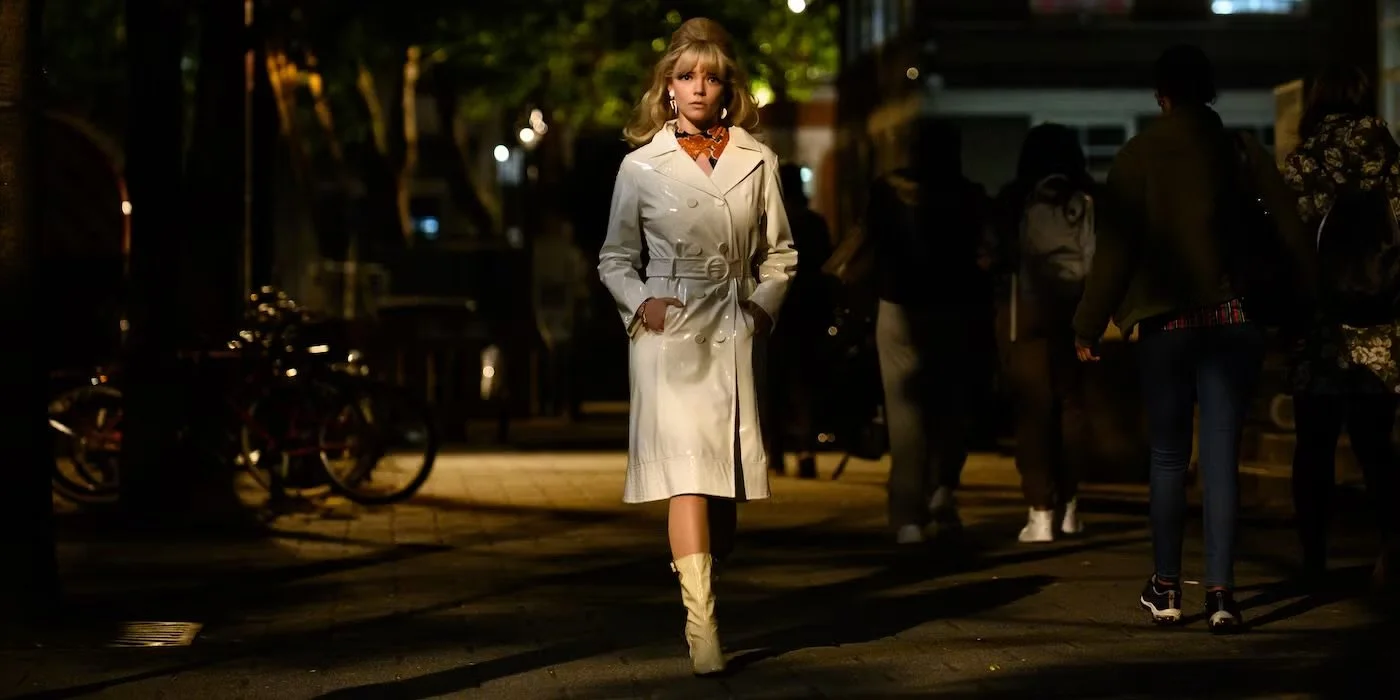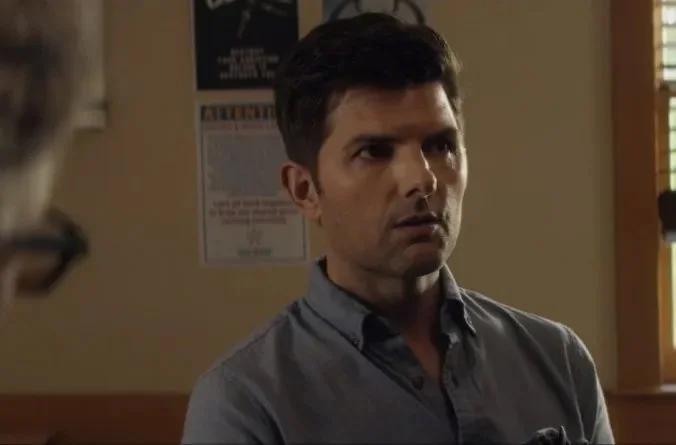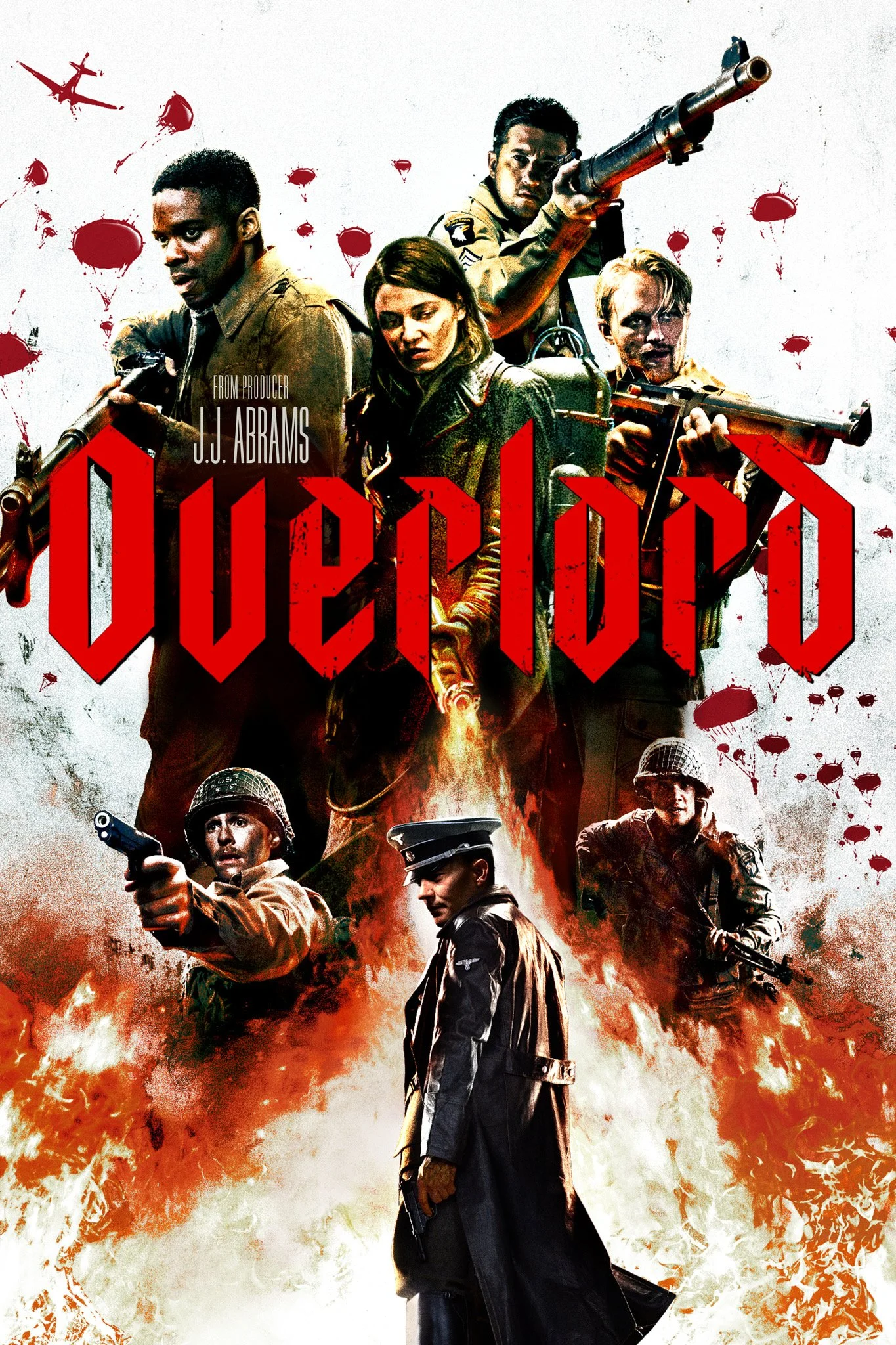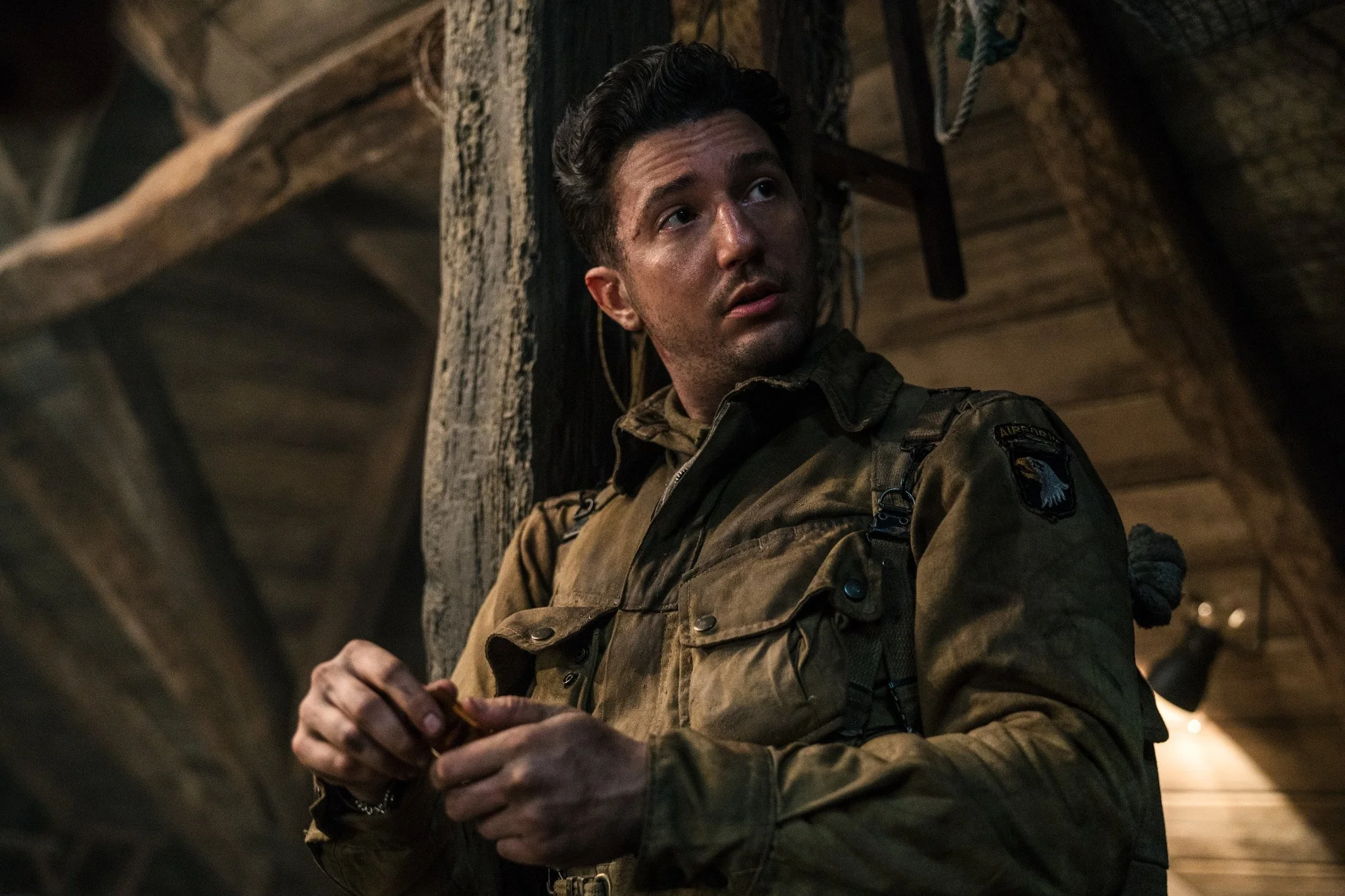[Content Warning: The following will contain discussions of sexual assault]
As we reach the end of spooky month with the big show tomorrow, I want to end my Halloween coverage with one of my favorite horror movies that is woefully underrated. A small town girl goes to the big city to make her dreams come true. It’s the romanticized Hollywood story, one we’ve seen a thousand times before. But now we know better. We know what that machine does to people, women in particular, and we know that romanticized times weren’t flawless, we just don’t remember the flaws or exhibit that willful blindness that makes us overlook the problems. It’s still an easy trap to fall into (like how I think the 80s had the best music and the best TV shows, but that’s just because I watch Miami Vice a lot), but we know better.
Eloise Turner doesn’t. When we first meet Ellie, played by Thomasin Mckenzie (Jojo Rabbit, The Power of the Dog), she’s listening to 60s music and dancing around in a homemade dress made of what looks like newspapers on the second floor of her grandmother’s house in Cornwall. She bumps into something, knocking down a photo and causing the record to skip. As she picks up the photo, a picture of her mother and grandmother, she looks up and sees her mother in mirror. She asks if it’s good news and her mother just smiles. It’s at that moment, her grandmother calls up to Ellie that she’s gotten a letter from the London College of Fashion. She opens it and it’s an acceptance letter to the school; her dream is coming true. It’s not London in the 60s, which is her dream place and moment in time, but it is London and it is her dream of becoming a fashion designer like her mom. Close enough, right? She’s absolutely thrilled and prepares for the train ride from Cornwall to London.
Did I mention that her mom is dead? Welcome to Last Night in Soho.
The music here really does a lot to sell this naive ingenue thing Ellie has going on and it plays very well into her romanticized views of London. Ellie very quickly realizes, though, that her idea of London in the 60s and what London is now are most definitely not the same when her cabbie turns out to be a major creep, to the point that she doesn’t want him to let her out in front of her building, so she gets out a couple blocks early and hides in a shop until he drives away. What’s more, when she does get to her housing, she walks right into a pit of mean girl vipers led by her inconsiderate (to say the least) roommate Jocasta who gets right to that thing mean girls do where they insult someone right to their face, but say it in a way that if they don’t know better, they won’t realize they’re being insulted. It doesn’t take Ellie too long to catch on, though, and she jumps at the opportunity to move into a bedsit near campus and get away from Jocasta and her gaggle of fiendish fashionistas. It’s an old room, hardly changed in decades; a harsh contrast from the ultra modern dormitory she was staying in and much more like her grandmother’s house. She feels at home in the ancient bedsit, bathed in the neon glow of Soho’s signage, and all is well. Until, of course, she goes to sleep and finds herself in a London night club in the 1960s as she gets a glimpse into the life of Sandie, played by Anya Taylor-Joy (The Gorge, The Witch), an aspiring starlet ready to sing on the big stage and won’t accept anything else. The glamour is intoxicating for Ellie and the only thing she can think of doing the next morning is going back to sleep so she can get back into Sandie’s world, even turning down invitations in the real world for her to socialize in order to do so (not that I can’t relate to turning down or even cancelling plans so I could stay home and go to sleep).
This first scene with Sandie is one of the most visually arresting things I’ve seen in film in a long time. In fact, the whole movie is a wondrous to behold visually. I hated looking down to take notes during this film because I didn’t want to take my eyes off a single frame of the movie. It is stunning and stylish in a way that most movies just aren’t these days and this initial scene has some of the best direction and editing and choreography I’ve ever seen. The use of mirrors to show Ellie and Sandie in the same place, the shot composition and the lighting; the movie just grabs your eyes and makes you want to hold them open so you don’t miss a thing. The most skillful exhibition of this is the scene where Sandie and Jack, the charming but oh-so-sleazy manager of girls, dance with Ellie seamlessly cutting in. It’s one of the most impressive scenes in a film I can remember watching and it left me with the sense of wide-eyed wonder that Ellie has before she leaves for London. There are many times while watching this movie that I said out loud to myself “This looks so damn good” and you just don’t get that in movies that often. And the majority of the film is made using practical effects and great editing, with minimal CGI. It’s really very impressive and for that alone Last Night in Soho is worth watching. But there’s so much more
We learn that Sandie is one of the girls who lived in Ellie’s bedsit, apparently ghosts are geolocked. There’s something called the Stone Tape theory which states that materials, like houses and rocks and other tangible things can house the memories of traumatic events in a form of energy and it seems that the film’s rules for the ghosts are at least informed by that. You know I’m not much for the paranormal, but I found that to be an interesting touch. As Sandie’s whirlwind life starts to affect Ellie, she starts feeling Sandie’s influence in her own life. She starts working on 60s-inspired clothing designs, using Sandie as her model in her drawings, she changes her hair to be closer to Sandie’s, she buys vintage clothes, she becomes more bold. It’s all going great until she has a creepy encounter with an old man (the late Terence Stamp) who hangs around the pub where she works; it leaves her feeling shaken, but not nearly as shaken as the following nights do.
What started as a ghostly flight of fancy, beautiful dreams of a beautiful dream come true, starts to turn into a nightmare as Ellie quickly discovers that Sandie’s life on stage isn’t nearly as glamorous as it seemed to be at first. Jack, played by Matt Smith (Doctor Who, Morbius, even though I’m sure he’d like it if we forgot that), wins over Sandie on the night they meet by defending her honor from a boorish degenerate and making promises of headlining at the Rialto right away instead of waiting for her shot at the Cafe De Paris by working as a coat check girl for years. And as Sandie watches her new reality set in, she sees Jack with an old face that lays bare the betrayal. Ellie finds herself sat in the audience of men—exclusively men—in sober suits, bathed in alcohol, dripping with lecherous energy. And she witnesses it firsthand; not only is Sandie not singing, she’s not center stage, and it’s not the kind of show she had envisioned. Tame by today’s standards, perhaps, but what happens next isn’t. Her job doesn’t end when she exits the stage, no; Jack is exploiting her exactly in the way you thought he would, promising her great things in return for letting these rich and powerful men use her however they please. Jack’s not a talent manager, he’s a pimp leveraging the hopes and dreams of young women to force them into sexual servitude. The film here has so many little details that show you the toll this is taking on Sandie, and Anya Taylor-Joy is absolutely at the top of her game here, which shouldn’t be a surprise because she’s one of the best actresses working today. From the little glances and looks and the way her body language changes as she weathers the advances of depraved men who fancy themselves a Lothario and yet can only manage encounters with women whose agency has been ripped from them without their consent, to the bruises on her leg that she attempted to cover with makeup that are only exposed when she’s dancing; there is so much visual storytelling here that as the credits rolled, I immediately wanted to start it over and watch it again.
The dreams get more and more intense, more and more violent in nature, and less content to remain in the dream world for Ellie to just visit. She is being haunted. From a window into fantasy come to life, her ghostly dreams become a violent nightmare from which she can’t escape. And through all this, there’s John, the nearly unbelievably sweet fellow fashion student who has a crush on Ellie and unfortunately gets caught up in the chaos. But he’s up for it and so supportive, I’m really happy that he was a character in the film even if he is solidly tertiary. John is played by Michael Ajao (Attack the Block) and is not only such a wholesome addition to the movie (but in a different way from Ellie, who is naive, John is a South London boy who managed to not become self-serving and cynical like Jocasta), he also provides some good comic relief as the tension mounts. Just enough that it gives you a breather from the action, but not so much that it distracts from the stakes. The movie cascades to a terrifying and dramatic finale with some big twists and turns along the way and even though I’d seen the movie before, I still found myself thoroughly gripped.
As a film, it is really very well executed. Edgar Wright’s direction and his whole crew put together such a wildly beautiful film to look at and his writing is truly cutting at times. I mean, it is Edgar Wright, so my expectations are high because movies like Hot Fuzz and Shaun of the Dead are favorites of mine and his other foray into more serious filmmaking, Baby Driver, despite starring two men I don’t want to talk about anymore, was a triumph of cinema. And still, for his first true horror movie, he impressed me, sailing over the very high bar he’s already set. And I cannot say nearly enough about the acting. Thomasin Mckenzie was perfectly cast as Ellie, she is convincing through every moment of the film, her every emotion felt genuine, and she is so expressive and puts in such a strong performance, it’s worthy of a true superstar. And that’s while being in a movie with Anya Taylor-Joy, who is already a superstar, and is positively magical in this role, especially in that aforementioned dancing scene with Jack and Ellie and when she sings a downbeat version of “Downtown”; her performance is absolutely magnetic. They’re two more of the reasons I couldn’t look away, their performances were both so captivating. And the movie offers some genuinely harrowing moments that are amplified by the strength of their acting.
I have heard some complaints that the movie isn’t scary enough, but I think some of those are missing the mark. Perhaps the manifestations of the haunting could have been more frightening, but I think the terror of the situation here is the real horror. Sandie and Ellie are living parallel terrors. Sandie is living through true real life horror that takes a seriously brutal turn. Time has shown that the entertainment industry preys on women, as recently as Harvey Weinstein and as far back as I can find. There is something truly, truly horrifying about the commoditization of women’s bodies; seeing Sandie’s agency stripped from her and what she had to endure with no escape, sexual assault after sexual assault, kept under the thumb of someone who clearly physically harms her if she steps out of line left me slightly sick to my stomach and I think it’s an aspect of this film that wasn’t talked about enough in 2021 when it was first released. Jack turned her from a human being into a product, from a person into a thing. The slow loss of hope as Sandie descends further into a life so far from the one she imagined, so far from the one that she came to London to create is heartbreaking and even on repeat viewing, I can’t help but feel her pain.
And Ellie is witnessing those horrors with an added layer of her own. Because of her abilities, alignment, her shining, whatever you want to call it if you want to call it anything in particular, her life spirals out of control. She develops an intense and justified fear of sleep because every time she closes her eyes she’s torn out of her world into one of depravity and broken dreams. Talk about creating dread in a film, our characters here are going through it and like Ellie, all we can do is witness it powerlessly. It’s true, the movie is approachable, even for a non-horror fan like me, but I don’t think that detracts from the movie at all. It’s a serious film with a serious message that is delivered in a way that still gives you hope that the situation will change in the future. At just under 2 hours, it’s not a short film, but it needed every minute of its length and not a single shot is wasted or overly long or unnecessary. Last Night in Soho takes its time to tell a deeply realized story and I cannot recommend it enough. It’s just so, so good and I get more out of it every time I watch it, which to me is a mark of a truly great movie. As of now, this R-rated movie available for streaming on Prime Video and is a great addition to your Halloween festivities.
Since we’re reaching the end of spooky season I would like to thank all of you for being here and reading along through my increased coverage. It has been a real joy, stepping outside of my comfort zone and focusing on a genre that I usually avoid and I hope that I was able to highlight the versatility and the heft of storytelling that come with the horror genre and its mechanics. It feels like ever since Get Out, we’ve had an explosion of art house horror that aims to do more than just terrify or disgust. And even though horror will likely never become a top genre for me, I’m here for it. I’ve come to really appreciate what it can do and its role in cinema to tell allegorical stories or engage in social commentary in ways similar to science fiction. And seeing more horror, I see how the genre’s mechanics can inform some truly great comedies and thrillers as well. Ironically, I fear I’m becoming a fan.
October also just about marks a full year since I started consistently writing this blog on a weekly basis and I have found some lovely readers who have reached out to me and discussed film and TV shows and even video games and that is something I truly cherish. And whether you’re one of them or an occasional reader, or someone who checks it out every week or even if this is your first time stumbling across this particular one man show, I value and appreciate each and every one of you. Have a happy and safe Halloween and I’ll see you next week.






























